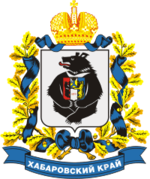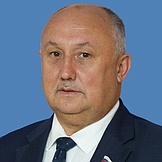Regional flags and emblems


PROFILE
Established 20 October 1938
Capital Khabarovsk
The Khabarovsk Territory is part of the Far Eastern Federal District
Area 787,600 sq km
Population 1 279 200 (2024)
Ethnic groups
(2020 National Census, %)
Russian – 92,86
Other – 7,14
Administrative divisions (2024)
Municipal districts – 17
City districts – 2
Rural towns – 22
Rural districts – 191
Geography and climate
The Khabarovsk Territory occupies the central part of the Far East. It has coastlines on the Sea of Okhotsk and the Sea of Japan. Relief: the Sikhote-Alin, Dzhugdzhur and Suntar-Khayat mountain ranges (the latter reaches an elevation of up to 2,889 m); the Lower Amur, Middle Amur, Evoron-Tugurskaya and Okhotskaya depressions; and the Middle Amur plain.
The Khabarovsk Territory extends 1,780 km from south to north and 700 km from west to east.
The Khabarovsk Territory borders the Republic of Sakha (Yakutia), the Primorye Territory, the Amur and Magadan regions and the Jewish Autonomous Region. A stretch of the Russian-Chinese border runs through the Khabarovsk Territory.
There are over 210,000 rivers and over 58,000 lakes in the area. Large rivers include the Amur, Amgun, Tunguska, Bureya, Anyui, Gorin, Gur and the Ussuri. Large lakes are Chukchagirskoye, Bolon, Udyl, Evoron, Ommi, Orel, Chlya and Bolshoye Kizi. The main waterway is the Amur River, which is included among the top ten largest rivers in the world and it is one of Russia’s most important rivers, as it is the nation’s third longest river and fourth largest in terms of the size of its river basin.
The climate is temperate monsoon in the south of the Khabarovsk Territory and subarctic in the north. The average January temperature is –26.4°C, with the average temperature of +17.7°C in July. Mean precipitation in January is 8 mm and 173 mm in July.
There are six nature reserves in the area (the Bolshekhekhtsirsky, Komsomolsky, Bureinsky, Botchinsky, Dzhugdzhursky, and Bolonsky), five wildlife refuges of federal importance, 23 wildlife refuges of regional significance, seven wildlife corridors, 14 natural landmarks and 18 protected nature areas of local importance.
Government
The legislative branch is represented by the single-chamber Legislative Duma of the Khabarovsk Territory, which is the permanent, representative and only legislative authority in the region.
The Legislative Duma of the Khabarovsk Territory has 36 deputies, with 24 of them running in single-mandate constituencies and the other 12 in the single electoral district, where winners are identified in proportion to the number of votes cast for lists of candidates nominated by electoral associations. The current Legislative Duma was elected in September 2019. Its term expires in September 2024.
The executive branch is the Government of the Khabarovsk Territory, is the collegial, supreme and permanent body of executive authority, there are also some other executive authorities.
The Governor of the Khabarovsk Territory is the region’s highest-ranking official, heads the executive branch of the Khabarovsk Territory. He is elected for five years by Russian citizens who permanently reside in the region. The term of the incumbent Governor expires in September 2024.
Economy and natural resources
The Khabarovsk Territory has the platform for the development of its industry and the innovative sectors of its economy. Plants produce high-technology competitive products and contribute to developing a skilled workforce.
The manufacturing sector includes mechanical engineering, metallurgy, metal processing, oil refining, as well as building materials, timber, woodworking, textile and food industries. The core enterprises are leading engineering plants in the defence, aircraft and ship-building industries. Defence plants address important national security issues.
The strategy of the local aircraft-building industry aims to expand the output of both military and civilian aircraft. The two leading aircraft plants are a subsidiary of the Sukhoi Company, the Gagarin Komsomolsk-on-Amur Aircraft Plant, and a subsidiary of the Sukhoi Civilian Aircraft Company based in Komsomolsk-on-Amur, both of which have been consolidated under the Integrated Aircraft Corporation [Obyedinyonnaya Aviastroitelnaya Korporatsiya].
The major shipyards are the Amur Shipyard and the Khabarovsk Shipyard, both of which are part of the Integrated Ship-Building Corporation [Obyedinyonnaya Sudostroitelnaya Korporatsiya]. The Amur Shipyard, the largest one in the Far East, has the capacity to build, repair and upgrade ships with displacements of up to 10,000 tonnes.
The mining sector is based on the proved reserves of coal, platinum, gold, tin, copper, building material, agrochemical raw materials, coloured stones, underground mineral water, therapeutic mud and mineral paint.
Electricity, gas and water are produced and supplied by local thermal power stations and combined heat and power stations. The energy sector’s leading companies are two subsidiaries of the Far Eastern Generating Company – Khabarovskaya Generatsiya and Khabarovskaya Teplosetevaya Kompaniya – and a subsidiary of the Far Eastern Distribution Company.
Agriculture accounts for about 5% of the gross regional product. The climate in the area is conducive to growing cereal crops, potatoes, vegetables and feed crops. Beef and dairy cattle breeding, pig breeding and poultry farming are well developed.
Two separate trunk railways run through the Khabarovsk Territory – the Trans-Siberian and Baikal-Amur mainlines, which are the principal transcontinental links connecting Europe and Asia. The Baikal-Amur Mainline is of major importance to the local economy as it handles the ever increasing amount of freight traffic to the Port of Vanino and the Port of Sovetskaya Gavan. The Khabarovsk Territory’s railway transport accounts for about 60% of freight traffic handled by the Far Eastern railway system.
Culture and tourism
In addition to having a highly diverse natural environment, the Khabarovsk Territory is where European and Asian cultures meet. There are over 720 federal and municipal institutions of culture and art, including theatres, museums, a Philharmonic with a concert hall, a circus, cinemas and libraries. The Grodekov Local History Museum is among the most popular tourist attractions.
Owing to its rich natural resources and the diversity of its flora and fauna, the Khabarovsk Territory is one of Russia’s unique regions. It is characterised by a mixture of northern and southern species of fauna and flora, as it is home to reindeer, brown bears, bighorn sheep, as well as Amur tigers and Himalayan bears. There are unique fish species in its rivers and lakes, such as great Siberian sturgeon and taimen, a species of salmon.
The area’s tourism potential has yet to be tapped, however, several recreation centres are very good and offer an entire range of services to tourists. Comfortable camping and holiday centres are concentrated in the vicinity of Khabarovsk and Komsomolsk-on-Amur. Other parts of the area are more appealing to wild campers and enthusiasts of hunting, angling, environmental tourism and rafting (the Anyui, Tuyun, Akishma and Kopi rivers). Lovers of extreme tourism are offered diverse activities, including mountain river rafting, angling tours, caving and winter recreational activities. The Mar Kyuel Plateau features karst formations and rivers that “vanish” underground.
Hunters will be delighted by the rich wildlife in the forests that includes ungulates and fur game, such as lynxes, Himalayan bears, Russian sables, minks, Siberian weasels and muskrats.
There are bird colonies and sea lion breading grounds on Nansikan Island in the Sea of Okhotsk. The Khabarovsk Territory is also a habitat for Far Eastern turtles.
The Anninskiye Vody spa resort 120 kilometres away from Nikolayevsk-on-Amur is the first health resort to be built in the Far East. It also has a balneo-therapeutical clinic. Anninsky Spring water has a beneficial effect and is used to treat patients with skin and gynecology conditions as well as motor impairments.

